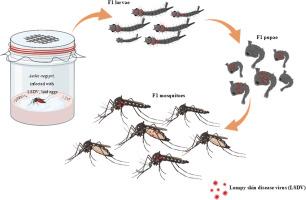埃及伊蚊经卵巢传播结节性皮肤病病毒的首个实验证据(双翅目:库蚊科)
IF 2.5
3区 医学
Q2 PARASITOLOGY
引用次数: 0
摘要
瘤状皮肤病病毒(LSDV)属于痘病毒科,可引起牲畜严重疾病。尽管LSDV传播的确切机制尚不清楚,但它被认为通过各种途径传播,包括直接和间接接触,以及节肢动物传播的病毒性疾病。虽然生物载体被认为是最有效的病毒宿主,但很少有研究探索潜在的LSDV载体。众所周知,埃及伊蚊是几种重要疾病的媒介,包括每年在动物和牲畜中引起广泛感染的结节性皮肤病。因此,了解LSDV与蚊子载体之间的相互作用,可以通过阻断病毒在其载体内的传播来制定控制LSDV自然爆发的替代策略。本研究旨在探讨伊蚊经卵巢传播LSDV的可能性。蚊。评估了后代蚊子的病毒感染情况。这项研究有望阐明Ae的作用。埃及伊蚊在LSDV中的生存能力,并评估蚊子媒介经卵巢传播的可能性。结果表明,Ae;埃及伊蚊是LSDV潜在的生物媒介。这是首次证明LSDV在Ae中可能经卵巢传播的研究。当埃及伊蚊感染了足够高的病毒载量在适当的时间。本文章由计算机程序翻译,如有差异,请以英文原文为准。

First experimental evidence of the transovarial transmission of lumpy skin disease virus by Aedes aegypti (Diptera: Culicidae)
Lumpy skin disease virus (LSDV), which belongs to the family Poxviridae, causes severe illness in livestock. Although the exact mechanisms of LSDV transmission remain unclear, it is thought to spread through various routes, including direct and indirect contact, as well as an arthropod-borne viral disease. Although biological vectors are considered the most effective virus reservoirs, few studies have explored potential LSDV vectors. Aedes (Ae.) aegypti is a well-known vector of several significant diseases, including lumpy skin disease, which is known to cause widespread infections in animals and livestock each year. Therefore, understanding the interaction between LSDV and mosquito vectors can lead to the development of alternative strategies for controlling LSDV outbreaks naturally by blocking virus transmission within its vectors. This study aimed to investigate the potential for the transovarial transmission of LSDV by Ae. aegypti. Viral infection in the subsequent generation of mosquitoes was evaluated. This research is expected to clarify the role of Ae. aegypti in LSDV viability and assess the potential for transovarial transmission in mosquito vectors. The findings indicated that Ae. aegypti is a potential biological vector of LSDV. This is the first study to demonstrate the potential transovarial transmission of LSDV in Ae. aegypti when infected with a sufficiently high viral load at an appropriate time.
求助全文
通过发布文献求助,成功后即可免费获取论文全文。
去求助
来源期刊

Acta tropica
医学-寄生虫学
CiteScore
5.40
自引率
11.10%
发文量
383
审稿时长
37 days
期刊介绍:
Acta Tropica, is an international journal on infectious diseases that covers public health sciences and biomedical research with particular emphasis on topics relevant to human and animal health in the tropics and the subtropics.
 求助内容:
求助内容: 应助结果提醒方式:
应助结果提醒方式:


